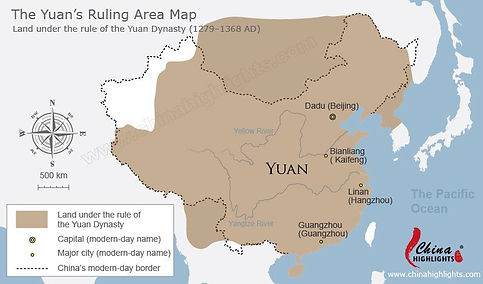Yuan
Dynasty
Yuan Dynasty

The Yuan dynasty 元 (1279-1368) was founded by Khubilai Khan, a grandson of the great Mongolian conqueror Činggis Qaɣan. The Yuan empire was one state (ulus) within the larger Mongolian unity of states. It included the three states that had formerly controlled the soil of China, namely the Tangutan Western Xia empire 西夏 (1038-1227), which was the first to be conquered by the Mongols, the Jurchen empire of Jin 金 (1115-1234), which was located in northern China, and the Southern Song empire 南宋 (1127-1279). The Yuan empire also included various Uyghurian communities in the region of modern Gansu and Xinjiang, as well as the Western Liao empire 西遼 (1124-1218) that had controlled the western parts of Xinjiang, as well as part of the steppe of Central Asia further west. The Mongols also won over control over Tibet by means of adopting Tibetan Buddhism ("Lamaism") as their religion.
Yuan dynasty, Wade-Giles romanization Yüan, also called Mongol dynasty, dynasty established by Mongol nomads that ruled portions and eventually all of China from the early 13th century to 1368. Mongol suzerainty eventually also stretched throughout most of Asia and eastern Europe, though the Yuan emperors were rarely able to exercise much control over their more distant possessions.
The emergence of the Mongol dynasty dates to 1206, when Genghis Khan was able to unify under his leadership all Mongols in the vast steppe lands north of China. Genghis began encroaching on the Jin dynasty in northern China in 1211 and finally took the Jin capital of Yanjing (or Daxing; present-day Beijing) in 1215. For the next six decades the Mongols continued to extend their control over the north and then turned their attention to southern China, which they completed conquering with the defeat of the Nan (Southern) Song dynasty in 1279.
Unlike other rulers of China, the Mongols were never totally Sinicized, which proved to be an important factor in their downfall. They continued to maintain their separateness from the native population and utilized foreigners, such as the European traveler Marco Polo, to staff the government bureaucracy. Revolts in the mid-14th century led to the final overthrow of the Yuan in 1368, making it the shortest-lived major dynasty of China. The administrative centrality of the Yuan was continued by the succeeding Ming (1368–1644) and Qing (1644–1911/12) dynasties, giving those later Chinese governments a more authoritarian structure than that of previous Chinese dynasties.
The Yuan administration followed patterns that had been created by the Song administration, but imposed also their own structure of improvisational government. On the local level, prefectures (zhou 州; in the map abbreviated with the sign ~; only these prefectures are indicated that are not supersided by a route lu 路) and superior prefectures (fu 府) were the mid-level administration units. There were also a few military prefectures (jun 軍) on the island of Hainan.
Capital of the Yuan empire was Dadu 大都 "Great Capital", known as Khanbalik (Qanbaliq "City of the Khan") and today as Beijing; the secondary capital was the Shangdu 上都 "Upper Capital" (Kaiping 開平; known as Xanadu in the western accounts), located near modern Dolonnur 多倫, Inner Mongolia. The old capital of the Mongols, Karakhorum (Qaraqorum, "Helin 和林"), was located in modern Mongolia.Khubilai Khan and his advisors adopted the institutions of the Chinese central government like the Palace Secretariat (zhongshusheng 中書省) as the core of their central government over China, first only for the territory in the north (the former Jin empire), but in the course of the conquest of China, it became necessary to found ad-hoc secretariats by the various division of the Mongol army
The final consolidation came under Genghis’s grandson Kublai Khan (reigned 1260–94). dministration that featured a centralized bureaucracy, political subdivisions, and a rationalized taxation system. Yuan was the first dynasty to make Beijing (called Dadu by the Yuan) its capital, moving it there from Karakorum (now in Mongolia) in 1267. The Yuan rebuilt the Grand Canal and put the roads and postal stations in good order, and their rule coincided with new cultural achievements including the development of the novel as a literary form. The vast size of the empire resulted in more-extensive foreign trade and foreign intercourse than at any other time before the modern period.

Although the Mongols had ruled territories including modern-day North China for decades, it was not until 1271 that Kublai Khan officially proclaimed the dynasty in the traditional Chinese style, and the conquest was not complete until 1279. His realm was, by this point, isolated from the other khanates and controlled most of present-day China and its surrounding areas, including modern Mongolia.It was the first foreign dynasty to rule all of China and lasted until 1368, after which the rebuked Genghisid rulers retreated to their Mongolian homeland and continued to rule the Northern Yuan dynasty.
These were called "en-route secretariats" (xing zhongshusheng 行中書省), a term later abbreviated as "secretariats" (sheng 省) and from the Ming period 明 (1368-1644) on used as the word for "province"). The Yuan empire was divided into eleven such "branch secretariates"